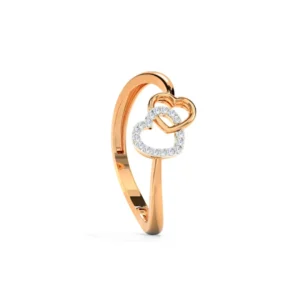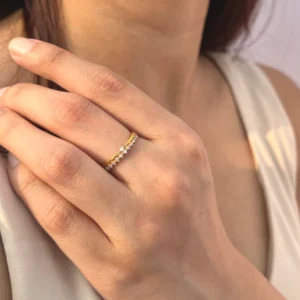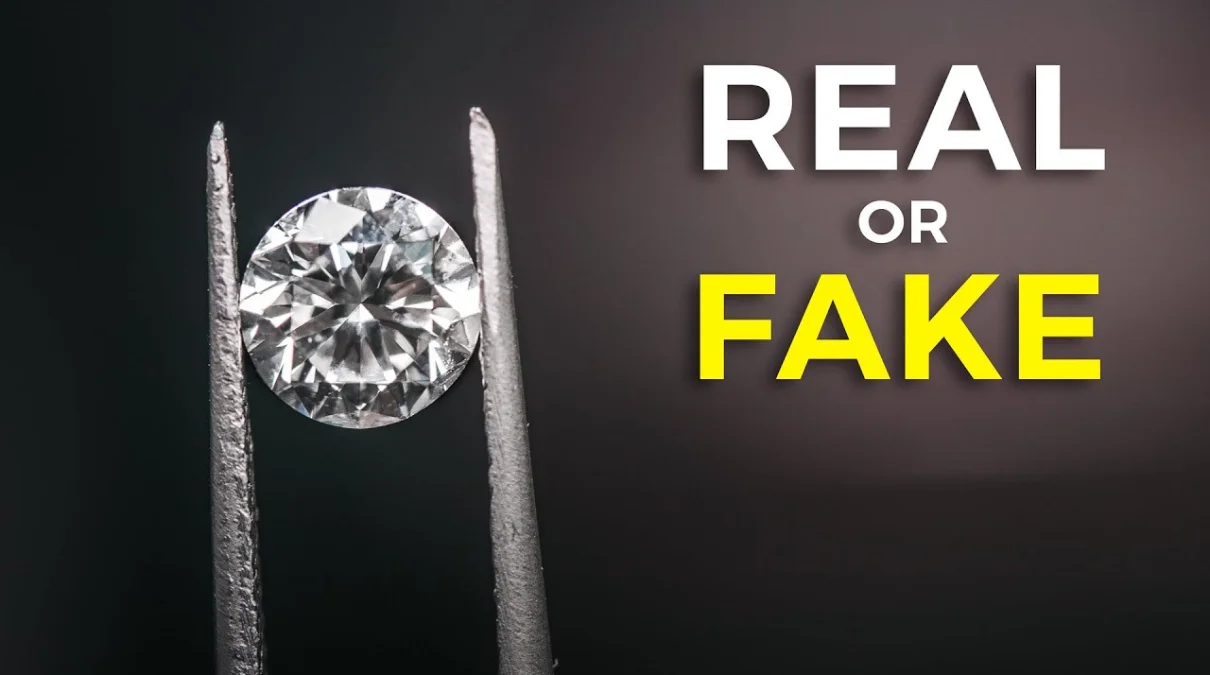How to Choose the Perfect Diamond Ring for Your Engagement
Choosing the perfect diamond ring for your engagement is an exciting but sometimes overwhelming experience. With so many options available, it’s essential to understand the basics of diamonds, settings, and personal preferences.
In this guide, we will take you through every step to help you select the ideal diamond ring that suits your style, budget, and lifelong commitment.
Introduction to Diamond Rings
An engagement ring is one of the most symbolic purchases you’ll ever make. It signifies love, commitment, and a promise to spend a lifetime together.
Choosing the right diamond ring involves more than just picking a pretty one – it’s about finding a ring that matches both your style and your partner’s personality.
Whether you want a traditional diamond ring or something unique, understanding the basics will ensure you make an informed decision.
-

 14KT Gold Diamond Barb Ring₹49,000.00
14KT Gold Diamond Barb Ring₹49,000.00 -

 14KT Gold Diamond Studded Crown Ring₹32,000.00
14KT Gold Diamond Studded Crown Ring₹32,000.00 -

 14KT Gold Meridian Solitaire Diamond Ring₹84,000.00
14KT Gold Meridian Solitaire Diamond Ring₹84,000.00 -

 14KT Gold Natural Diamond Spring Ring₹31,250.00
14KT Gold Natural Diamond Spring Ring₹31,250.00 -


-


-


-


-


-


Understanding the 4 Cs of Diamonds
The 4 Cs — cut, color, clarity, and carat — are the foundation of choosing a diamond. These are the universal criteria jewelers use to determine a diamond’s quality and value.
Cut
The cut of the diamond refers to how well it has been shaped and polished. A well-cut diamond reflects light beautifully, making it sparkle. The better the cut, the more brilliance and fire (colorful light flashes) the diamond will show. Ideal or excellent cuts are recommended for the most brilliance.
Color
Diamonds come in a variety of shades. The less color a diamond has, the higher its grade. Color is graded on a scale from D (colorless) to Z (noticeable color, usually yellow or brown). Most buyers prefer diamonds in the D-G range because they appear colorless to the naked eye and are more affordable than true D-grade diamonds.
Clarity
Clarity refers to how free a diamond is from internal flaws (inclusions) or surface imperfections (blemishes). The fewer inclusions a diamond has, the clearer and more valuable it is. Clarity is graded from FL (flawless) to I (included). VS1 and VS2 diamonds offer a great balance between clarity and price, as their imperfections are invisible to the naked eye.
Carat
Carat refers to the weight of the diamond. A higher carat means a larger, heavier diamond, but carat weight alone doesn’t determine the beauty of the stone. A well-cut smaller diamond can appear larger than a poorly cut, larger one.
Choosing the Diamond Shape
Diamond shape is different from cut and refers to the actual form or outline of the diamond. Popular shapes include:
- Round: Classic and brilliant, the round diamond maximizes sparkle.
- Princess: A modern, square shape with sharp edges.
- Oval: Elongated and elegant, it can make fingers appear longer.
- Cushion: Soft, rounded corners give this square shape a vintage look.
- Emerald: Rectangular with step cuts, offering a sophisticated appearance.
- Marquise: An elongated shape with pointed ends, maximizing carat weight.
Choosing the right shape is often about personal preference. Some people prefer the traditional round diamond, while others may want a unique shape like pear or marquise.
Types of Diamond Settings
The setting is how the diamond is placed into the band. It plays a key role in the ring’s appearance and security.
Prong Setting
The most common setting, prongs are small metal claws that hold the diamond securely. This setting allows maximum light to hit the diamond, enhancing its sparkle.
Bezel Setting
A bezel setting surrounds the diamond with a metal rim. It’s a great choice for those with an active lifestyle since it protects the diamond better than other settings.
Pavé Setting
Small diamonds are embedded into the band of the ring, giving the illusion of a diamond-encrusted surface. It’s a delicate and stunning option that adds sparkle.
Halo Setting
A halo setting features a center diamond surrounded by a circle of smaller diamonds, which can make the center stone appear larger.
Metal Choices for Engagement Rings
The metal you choose for the ring band will affect both the look and durability of the engagement ring. Popular metals include:
Gold
- Yellow Gold: Traditional and timeless.
- White Gold: Offers a contemporary look similar to platinum.
- Rose Gold: A romantic and trendy option.
Platinum
Platinum is a durable and hypoallergenic metal. It has a natural white sheen and doesn’t tarnish easily, making it a popular but more expensive option.
Silver
Silver is less durable than gold or platinum but offers an affordable option with a classic look.
Diamond Certification and Why It’s Important
Always buy a certified diamond to ensure you’re getting the quality you paid for. The most trusted certification comes from organizations like the GIA (Gemological Institute of America) and AGS (American Gem Society). These certificates verify the diamond’s authenticity and provide detailed information about its 4 Cs, helping you make a confident purchase.
Also Read: How to Tell if a Diamond is Real or Fake- Real Guide
Understanding Your Budget
Determining your budget before you start shopping will make the process easier and more enjoyable. A common rule of thumb suggests spending two to three months of your salary on an engagement ring, but this isn’t a hard rule. It’s important to spend within your means and choose a ring that feels right for you and your partner.
Also Read: How Much Should You Spend on a Wedding Ring?
-

 14KT Gold Diamond Barb Ring₹49,000.00
14KT Gold Diamond Barb Ring₹49,000.00 -

 Gold Natural Diamonds Hearty Band₹28,750.00
Gold Natural Diamonds Hearty Band₹28,750.00 -

 14KT Gold Diamond Studded Crown Ring₹32,000.00
14KT Gold Diamond Studded Crown Ring₹32,000.00 -

 Gold Natural Diamond Studded Heart Ring₹37,500.00
Gold Natural Diamond Studded Heart Ring₹37,500.00 -

 Gold Diamond Double Crown Wedding Ring₹32,000.00
Gold Diamond Double Crown Wedding Ring₹32,000.00
Popular Diamond Ring Styles
Your diamond ring’s style should reflect your partner’s personality and taste. Here are some popular styles to consider:
Solitaire
A single diamond on a simple band. Timeless and elegant.
Three-Stone
Three diamonds, often symbolizing the past, present, and future.
Vintage
Incorporates antique designs and intricate detailing for a timeless look.
Modern
Sleek, minimalist designs with contemporary elements like tension settings.
Considering the Wedding Band
While shopping for an engagement ring, consider how it will pair with a wedding band. Some engagement rings are designed to fit flush with a wedding band, while others may require a custom band.
Also Check: Perfect Match: Finding the Wedding Band that Complements Your Engagement Ring
Personalising the Ring
Personal touches can make the ring even more special. Some ways to personalize include:
- Custom Engravings: Add a meaningful message inside the band.
- Unique Design Elements: Choose a custom design that represents a shared interest or memory.
Where to Buy: Local Jeweler vs. Online
You can buy an engagement ring from a local jeweler or through reputable online stores. Both options have their pros and cons:
- Local Jeweler: Allows you to see the ring in person and develop a relationship with the jeweler.
- Online: Offers a wider selection and sometimes better prices. Just make sure the retailer offers certification and a good return policy.
Insuring Your Engagement Ring
Once you’ve purchased the perfect ring, it’s essential to insure it. Insurance protects against theft, loss, or damage, giving you peace of mind.
Conclusion: Making the Right Choice
Choosing the perfect diamond ring for your engagement is a meaningful process that requires thought and consideration. By understanding the 4 Cs, selecting the right shape and setting, and keeping your budget in mind, you can find a ring that symbolizes your love and commitment. Take your time, do your research, and make the decision that feels right for you and your partner.










